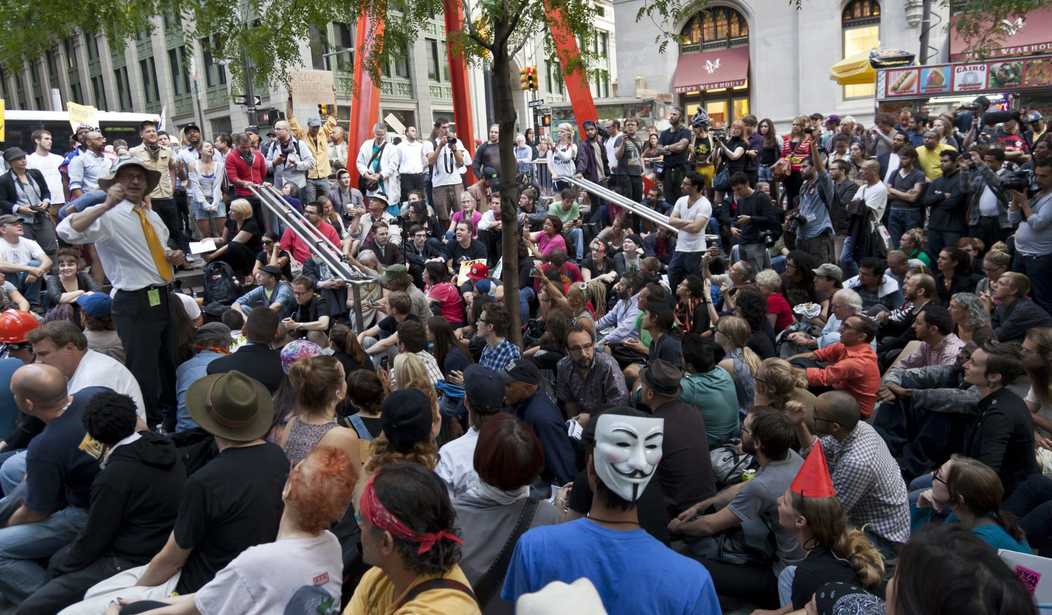As the New York Democratic primary heats up, the original forces behind Occupy Wall Street, and some new activists inspired by that cause, are supporting the underdog in the race, Bernie Sanders. Sanders’ self-described “socialist” economic message seems a good fit for the protesters who lambasted the 1 percent, while causing mayhem in public parks in 2011.
In addition to the traditional campaign tactics of phone calls and door knocks, Occupy-aligned groups will be compiling a newspaper of sorts and leading a march through New York City’s financial district.
Local organizers are finding Sanders’ message a logical extension, and even a validation, of the original Occupy Wall Street (OWS) rallying cry.
“Occupy was a reaction to the financial collapse, to what happened because of Wall Street’s power to destroy the economy, and Bernie’s campaign is the one that has been consistently focused on the role of the ‘1 Percent,’ large corporations and financial institutions,” Charles Lenchner, an organizer who co-founded “People for Bernie” after failing to convince Sen. Elizabeth Warren to run for president.
Winnie Wong, an OWS activist and fellow “People for Bernie” co-founder, also emphasized the connection. “This is the place where the message of income inequality resonated across the country and across the world — it’s where it really began,” Wong told CNN. Sanders, she said, “is bringing it back home.”
Sanders’ methods have galvanized former OWS activists, as they appreciate both his ideas and his campaign’s unique blend of social media-driven protests. “Canvassing and using apps to get people to vote and all that micro targeting stuff, that’s important, but so is marching in the streets,” Lenchner declared. Lenchner and Wong’s “People for Bernie” launched the “Feel the Bern” hashtag, which has become immensely popular and serves as a potent organizing tool.
Prominent OWS organizer Beka Economopoulos also pledged her fealty to the Bern, leading a March phone-bank for Sanders from Zuccotti Park, the infamous birthplace of Occupy.
In 2011, at the height of OWS, Sanders publicly supported the movement. “I applaud them,” the Vermont senator told CNN’s Wolf Blitzer. “They are speaking to the real anger and frustration that millions of Americans feel at a time when the middle class is collapsing, powerful is increasing, the people on do are doing phenomenally well.”
The movement itself seemed a natural springboard for Sanders’ presidential campaign. “Occupy Wall Street helped create the political climate that helped Bernie’s message to resonate so widely, simply by shining a spotlight on issues of Wall Street greed and income inequality,” declared Sanders spokeswoman Karthik Ganapathy.
“We’ve been able to tap into the energy of [the movement] and channel that into something tangible and concrete and forward-looking,” the spokeswoman added. She noted that many of the original OWS activists have joined Sanders’ campaign. “I see a lot of them volunteering, making phone calls, knocking on doors, it’s a natural fit.”
Next Page: How OWS Can Propel Sanders in New York
The protesters who once invaded public spaces around Wall Street are now drafting propaganda for Sanders. Independent journalists and activists behind the free “Occupied Wall Street Journal” pamphlets in 2011 have undertaken a massive project to produce 500,000 bilingual broadsheet newspapers. The special edition, as part of their “Battle of New York” project, which they aim to print on Wednesday, will include essays and art, along with a direct call to vote for Sanders next Tuesday.
On Saturday, Millennials for Bernie will lead a “March for Bernie” from Foley Square in Manhattan’s financial district to Union Square, a path which traces a 2011 protest march. Organizers say they expect a crowd of 15,000 people.
Heather Hurwitz, a post-doctoral fellow at Barnard College, said this kind of campaign march is unique. Hurwitz said it “isn’t very typical in our electoral politics” that “a presidential candidate has sparked people to use the protest tactic of marches.” She argued that there is a clear inspiration from OWS in this march, despite the fact that the organizers were not involved in the 2011 movement.
While most union leaders have endorsed Clinton, the rank-and-file form a large portion of Sanders’ New York coalition. Communications Workers of America political director Bob Master says Verizon workers who went on strike in 2011 benefitted from OWS’s public visibility. Today, the workers are without a contract, and thousands began a strike Wednesday morning. Sanders backed them in a rally on Monday night.
Bernie Sanders in solidarity with @CWAUnion ahead of Wednesday’s strike. https://t.co/2JKTMnQRNR
— Bhaskar Sunkara (@sunraysunray) April 12, 2016
“Bernie’s campaign — like the de Blasio campaign (for New York City mayor in 2013), like the Warren campaign (for Senate in 2012) — are lineal descendants of Occupy,” Master told CNN. “These campaigns, and Sanders most dramatically, are Occupy Wall Street translated into electoral politics. This is the revolt of the 99%.”
Sanders might not be the only candidate receiving support from an early 2010’s movement. The Tea Party Patriots Citizens Fund, the largest Tea Party group in America, endorsed Ted Cruz in January, and the Club for Growth endorsed Cruz last month. Nonetheless, one of the Tea Party’s original founders backed Republican frontrunner Donald Trump.
It could be argued that while Cruz represents the ideological tenets of the Tea Party, Trump stands for the spirit of protest. Sanders unites the two sides of Occupy Wall Street, which makes him such a great fit for their movement.
Despite this OWS support, Sanders still seems poised to lose New York to Hillary Clinton. Some might say the same thing that was said of Occupy in 2011: good riddance.









Join the conversation as a VIP Member